On 24 September, a beautiful autumnal Saturday, about a dozen BACSA members enjoyed a tour of Brookwood Cemetery, Surrey, planned by Rosemary Raza (BACSA) and Ms Kim Lowe, Chairwoman of the Brookwood Cemetery Society. For most of us, the sight of some majestic trees glimpsed through a train window was all we previously knew of this 200+ acre 19th century cemetery, the landscaped grounds of which are now a Grade 1 listed site.
Founded in 1852 by the London Necropolis and National Mausoleum Company, Brookwood, the largest cemetery in the UK with around 240,000 burials, is currently owned by Woking Borough Council. Of particular interest to BACSA members are the many graves of people who either came from, or spent a significant part of their lives in, South Asia.
On arrival we were welcomed with refreshments at the Cemetery Society office, following which our Tour Guide, Barry Devonshire, outlined the proposed itinerary, and our minibus took us to the Muslim and Parsee burial grounds in the north (‘Non-conformist’) side of the site. Our first stop was the grave of Princess Musbah Haidar (1918-1977), a direct descendant of the prophet Muhammed, and the author of Arabesque: an account of Harem Life (1944) and Dawn beyond the Tamarisks (1953).
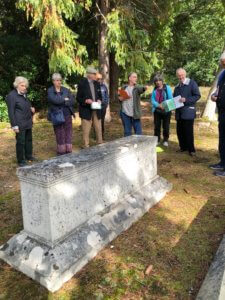
R Raza
Close by are the graves of two men who were responsible for translating the Koran into English: Abdullah Yusuf Ali (1872-1953) and Mohammed Marmaduke Pickthall (1875-1936). Lord Headley (1855-1935), who became the first President of the British Muslim Society, and the first peer to perform the Hajj, is also buried there.
The Rt. Hon. Syed Ameer Ali (1849-1928), a historian, lawyer and founding member of the All India Muslim League (1877), who became the first Indian Privy Councillor (in 1909), and Chairman of the Woking Mosque Committee, is buried nearby.
Further along, a neat line of WW1 headstones, carefully angled towards Mecca, poignantly marks the graves of 13 Indian sepoys who died in military hospitals in SE England.
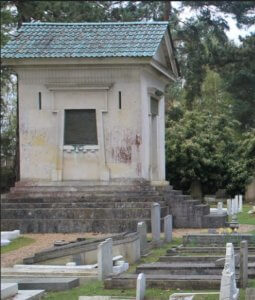
Tim Sheerman-Chase
The Zoroastrian (Parsee) Cemetery, opened in 1862, is the only one of its kind in Europe. The Wadia mausoleum commemorates Nowrosjee Wadia (1849-1899), who studied textile production in Lancashire before buying mills and developing the cotton industry in Bombay. Designed by Thomas Colcut, and based on the tomb of Cyrus, King of Persia, at Pasargadae, the mausoleum is built in seven stepped stages representing the ‘heavenly mountain’ in the centre of the Zoroastrian ground.
Similar in structure are three nearby mausoleums for members of the Tata family who ‘industrialised India’: Jamsetji Tata (1839-1904), Ratam Tata (1871-1918), and Sir Dorabji Tata (1859-1932).
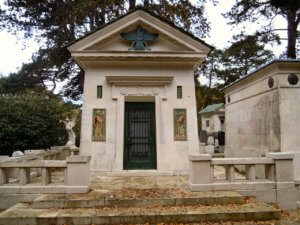
Designed by Gilbert Bayes, Sir Dorabji Tata’s mausoleum is made of Portland stone. Its walls are decorated with brick-glazed, Persian-style friezes, and the roof is covered with terracotta glazed tiles.
Our group then moved to the chapel on the south (‘Anglican’) side of the Cemetery, where, after a delicious lunch provided by the Cemetery Society volunteers, Barry gave us a short presentation on the second part of our tour.
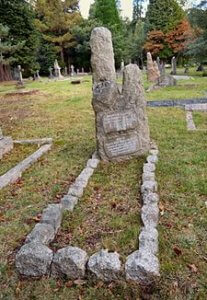
Wikipedia
Allen Octavian Hume (1829-1912), who founded the Indian National Congress after retiring from the Bengal Civil Service, is buried near the chapel. A keen ornithologist, he co-authored a standard work on Indian game birds in 1881, before donating his collection of bird skins and eggs to the British Museum of Natural History.
Sir Samuel Swinton Jacob (1841-1917), Chief Engineer of Jaipur, Rajasthan, is also buried at Brookwood. Inspired by the mosques, temples, forts and tombs of North India, and deeply respectful of local building traditions and skills, Jacob pioneered the Indo-Saracenic style of architecture, incorporating exquisite stonework in chhajas (balconies), chhatris (domed pavilions), jaalis (lattices), arches and columns in his buildings (the Albert Hall Museum at Jaipur being an outstanding example).
Two Victoria Cross holders buried at Brookwood were awarded their medals for valour displayed during the 1857 Mutiny / War of Independence.
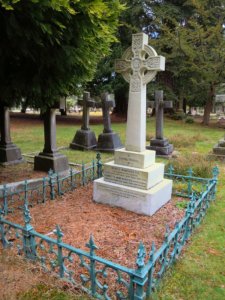
The first, Ross Lowis Mangles VC (1833-1905), an assistant magistrate at Patna, received his medal for actions during the relief of Arrah (30 July 1857), becoming one of the earliest civilians to be awarded a VC.
The second, Lance Corporal James Hollowell VC (c.1825-1876), received his medal for valour during the relief of Lucknow (26 September 1857), and was buried in an unmarked grave in the Corps of Commissionaires plot. In 2020 his regiment erected a CWGC-pattern headstone as a permanent memorial to him. (Click here to read more about James Hollowell’s story).
Barry also pointed out the grave of Florence Baird Smith, whose husband Richard, an HEIC engineer working on the Rorkee Canal, played a prominent part in the Siege of Delhi (June-September 1857).
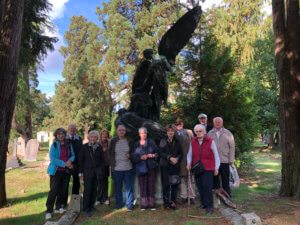
24 September 2022 R Raza
Other graves visited included those of Mary Bartle Frere (1845-1911), whose book Old Deccan Days (‘Hindoo Fairy Legends, collected from oral traditions’) was published in 1868; Ralph Strachey (1868-1923, Chief Engineer, East Indian Railway), and Sir George Le Grand Jacob (1805-1881, Major-General in the Indian Army).
As the photo of our group (standing by a memorial to Lady Matilda Jane Pelham Clinton, c.1825-1892), shows, we spent a fascinating day in delightful surroundings.
Our thanks are due to Barry Devonshire, our tour guide; to Ms Kim Lowe, Chairwoman of the Brookwood Cemetery Society, who helped considerably with the planning; to the other BCS volunteers who helped ensure our creature comforts, and to Rosemary Raza, who organised the trip.
By BACSA member Rachel Magowan
